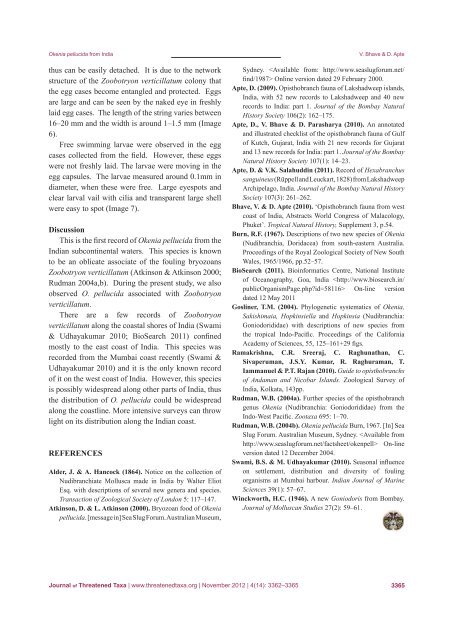View - Journal of Threatened Taxa
View - Journal of Threatened Taxa
View - Journal of Threatened Taxa
Create successful ePaper yourself
Turn your PDF publications into a flip-book with our unique Google optimized e-Paper software.
Okenia pellucida from Indiathus can be easily detached. It is due to the networkstructure <strong>of</strong> the Zoobotryon verticillatum colony thatthe egg cases become entangled and protected. Eggsare large and can be seen by the naked eye in freshlylaid egg cases. The length <strong>of</strong> the string varies between16–20 mm and the width is around 1–1.5 mm (Image6).Free swimming larvae were observed in the eggcases collected from the field. However, these eggswere not freshly laid. The larvae were moving in theegg capsules. The larvae measured around 0.1mm indiameter, when these were free. Large eyespots andclear larval vail with cilia and transparent large shellwere easy to spot (Image 7).DiscussionThis is the first record <strong>of</strong> Okenia pellucida from theIndian subcontinental waters. This species is knownto be an oblicate associate <strong>of</strong> the fouling bryozoansZoobotryon verticillatum (Atkinson & Atkinson 2000;Rudman 2004a,b). During the present study, we alsoobserved O. pellucida associated with Zoobotryonverticillatum.There are a few records <strong>of</strong> Zoobotryonverticillatum along the coastal shores <strong>of</strong> India (Swami& Udhayakumar 2010; BioSearch 2011) confinedmostly to the east coast <strong>of</strong> India. This species wasrecorded from the Mumbai coast recently (Swami &Udhayakumar 2010) and it is the only known record<strong>of</strong> it on the west coast <strong>of</strong> India. However, this speciesis possibly widespread along other parts <strong>of</strong> India, thusthe distribution <strong>of</strong> O. pellucida could be widespreadalong the coastline. More intensive surveys can throwlight on its distribution along the Indian coast.ReferencesAlder, J. & A. Hancock (1864). Notice on the collection <strong>of</strong>Nudibranchiate Mollusca made in India by Walter EliotEsq. with descriptions <strong>of</strong> several new genera and species.Transaction <strong>of</strong> Zoological Society <strong>of</strong> London 5: 117–147.Atkinson, D. & L. Atkinson (2000). Bryozoan food <strong>of</strong> Okeniapellucida. [message in] Sea Slug Forum. Australian Museum,V. Bhave & D. ApteSydney. Online version dated 29 February 2000.Apte, D. (2009). Opisthobranch fauna <strong>of</strong> Lakshadweep islands,India, with 52 new records to Lakshadweep and 40 newrecords to India: part 1. <strong>Journal</strong> <strong>of</strong> the Bombay NaturalHistory Society 106(2): 162–175.Apte, D., V. Bhave & D. Parasharya (2010). An annotatedand illustrated checklist <strong>of</strong> the opisthobranch fauna <strong>of</strong> Gulf<strong>of</strong> Kutch, Gujarat, India with 21 new records for Gujaratand 13 new records for India: part 1. <strong>Journal</strong> <strong>of</strong> the BombayNatural History Society 107(1): 14–23.Apte, D. & V.K. Salahuddin (2011). Record <strong>of</strong> Hexabranchussanguineus (Rüppell and Leuckart, 1828) from LakshadweepArchipelago, India. <strong>Journal</strong> <strong>of</strong> the Bombay Natural HistorySociety 107(3): 261–262.Bhave, V. & D. Apte (2010). ‘Opisthobranch fauna from westcoast <strong>of</strong> India, Abstracts World Congress <strong>of</strong> Malacology,Phuket’. Tropical Natural History, Supplement 3, p.54.Burn, R.F. (1967). Descriptions <strong>of</strong> two new species <strong>of</strong> Okenia(Nudibranchia, Doridacea) from south-eastern Australia.Proceedings <strong>of</strong> the Royal Zoological Society <strong>of</strong> New SouthWales, 1965/1966, pp.52–57.BioSearch (2011). Bioinformatics Centre, National Institute<strong>of</strong> Oceanography, Goa, India On-line versiondated 12 May 2011Gosliner, T.M. (2004). Phylogenetic systematics <strong>of</strong> Okenia,Sakishimaia, Hopkinsiella and Hopkinsia (Nudibranchia:Goniodorididae) with descriptions <strong>of</strong> new species fromthe tropical Indo-Pacific. Proceedings <strong>of</strong> the CaliforniaAcademy <strong>of</strong> Sciences, 55, 125–161+29 figs.Ramakrishna, C.R. Sreeraj, C. Raghunathan, C.Sivaperuman, J.S.Y. Kumar, R. Raghuraman, T.Iammanuel & P.T. Rajan (2010). Guide to opisthobranchs<strong>of</strong> Andaman and Nicobar Islands. Zoological Survey <strong>of</strong>India, Kolkata, 143pp.Rudman, W.B. (2004a). Further species <strong>of</strong> the opisthobranchgenus Okenia (Nudibranchia: Goniodorididae) from theIndo-West Pacific. Zootaxa 695: 1–70.Rudman, W.B. (2004b). Okenia pellucida Burn, 1967. [In] SeaSlug Forum. Australian Museum, Sydney. On-lineversion dated 12 December 2004.Swami, B.S. & M. Udhayakumar (2010). Seasonal influenceon settlement, distribution and diversity <strong>of</strong> foulingorganisms at Mumbai harbour. Indian <strong>Journal</strong> <strong>of</strong> MarineSciences 39(1): 57–67.Winckworth, H.C. (1946). A new Goniodoris from Bombay.<strong>Journal</strong> <strong>of</strong> Molluscan Studies 27(2): 59–61.<strong>Journal</strong> <strong>of</strong> <strong>Threatened</strong> <strong>Taxa</strong> | www.threatenedtaxa.org | November 2012 | 4(14): 3362–33653365

















